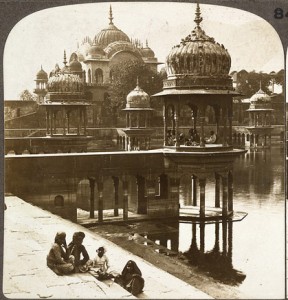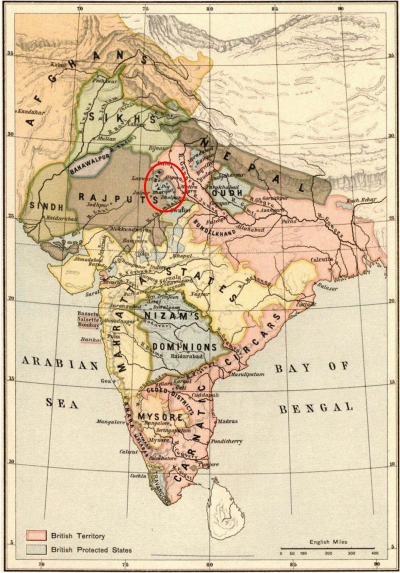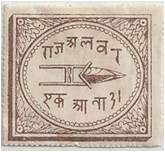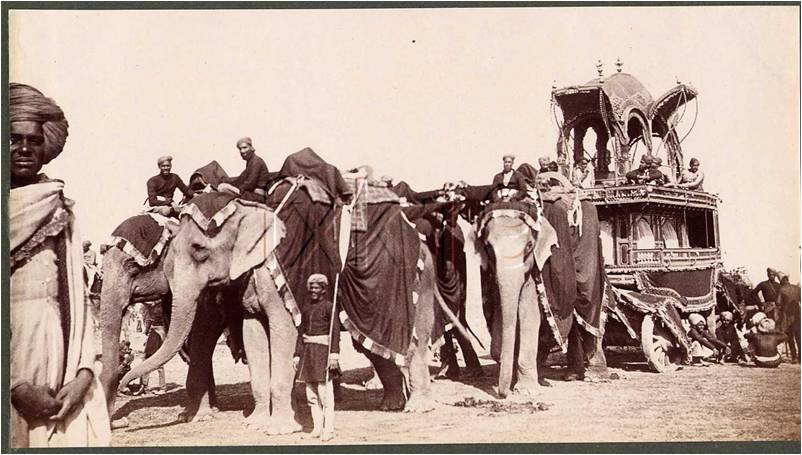Fast Facts
Region: India Area
Group: India Feudatory State
Classification: Semi-Autonomous State
Prior Regime: Maratha Empire
Key Dates:
1771 – Alwar becomes a Rajput Kingdom
1803, Nov 14 – Alwar signs with British East India Company and becomes British Protectorate
1948, Mar 18 – Merged with Bharatpur, Dholpur and Karauli to form the Matsya Union
Following Regime: Matsya Union, then Republic of India
First Stamp Issued: 1877
Scott Catalogue: (India Feudatory States, Alwar) #1-4
Pick Catalogue: none
History

A few years later, Bakhtawar Singh ventured an armed incursion into neighboring Jaipur, but was defeated. Eventually, he was prohibited from political communications with other states without British consent.
British colonial authorities ruled India with two administrative systems. About 60% of territory of the Indian sub-continent were provinces and territories directly under British colonial administration, 40% of the sub-continent were native Indian (“princely”) States under direct treaty relations with British India.
Alwar state had a often turbulent relationship with the British, depending on the maharaja who led the state. On March 18, 1948, the state merged with three neighboring princely states (Bharatpur, Dholpur and Karauli) to form the Matsya Union. This union in turn merged unto the Union of India. On May 15, 1949, it was united with certain other princely states and the territory of Ajmer to form the present-day Indian state of Rajasthan.
Stamps
 ALBUM
ALBUM
For India States, stamp collectors divide the states that issued stamps into two camps. Feudatory States ran their own post and issued stamps which were valid within that particular state. Convention states had an agreement (aka convention) with the British India postal system to handle internal postage, and overprinted stamps of British India with the particular state.
Alwar is considered a Feudatory state. Four stamps of the same design were issued for Alwar. The design featured an Alwar dagger known as a Kandjar. The dagger was of a unique design, when squeezed, the blades would open like scissors inside it’s victim. The stamps were first recorded in February 1877 buy may have been issued as early as September 1876. They continued in use until 1 July 1902, when the postal service in Alwar was taken over by the British Imperial Post. The stamps were only used in Alwar State.
Banknotes
Although a few of the Indian Princely states issued local currency, most, including Alwar, used Britsh Indian Currency. Alwar was distinguished however, as the first princely state to use coins struck at Calcutta Mint.
Links
Alwar: From Mark Jochim at Philatelic Pursuits
Map at Sandafayre On Line Atlas






My family migrated from India, Alwar State, my grandfather Shamsher khan came along with my father nawab khan in 1950, i want to know more about my family, is there anyone relative lives over there, or any record is available in india? can anyone help me out?
Hi Muhammad
Welcome to DCStamps. Sorry I can’t help you with genealogy. I would suggest you google search Alwar and Genealogy to find information.
Regards
Michael
This refers to the Alwar album. Alwar never issued any stamp of 1/2A denomination. The 1877 ultramarine stamp and the 1899 slate blue stamp were printed at 1/4A which was the basic minimum postage for a letter in the state of Alwar. Again, the only 1A issue (1877) was printed in pale yellow brown color, never in yellow green color.